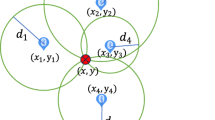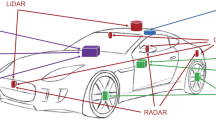Abstract
Device-free localization (DFL) systems have aroused extensive attention because it is more convenient than device-enabled localization systems, and fingerprint-based localization method is usually used in DFL systems. Although fine-grained information can be provided by the channel state information (CSI), but changes in the environment over time can cause the CSI become different. Therefore, the real-time CSI data can’t match with the data in the fingerprint map established beforehand very well, which can lead to the inaccuracy of the positioning result. This paper presents a DFL system, which adopts transfer learning method to update the fingerprint map and employs the Light Gradient Boosting Machine (LightGBM) algorithm to train the fingerprint map. Wavelet transform is used in this paper to filter the noise in the raw CSI data and the CSI data on a portion of the fingerprint points are collected to update the established fingerprint map by joint distribution adaptation in the update stage. After classifying the CSI data of the testing point by LightGBM, the position coordinate is achieved by the confidence regression method. By using LightGBM, the proposed system can achieve the average distance error of 0.48m, outperforming the result by using eXtreme Gradient Boosting (XGBoost) and Gradient Boost Decision Tree (GBDT). According to the result of the four-week experiment, the average distance error of this system can be decreased by 21% compared with not using the calibration method.















Similar content being viewed by others
References
Pala, S., Jayan, S., & Kurup, D. G. (2020). An accurate UWB based localization system using modified leading edge detection algorithm. Ad Hoc Networks, 97, 102017.
Tarricone, L., & Grosinger, J. (2020). Augmented RFID technologies for the internet of things and beyond. Sensors, 20, 987.
Wang, Q., Yin, X., Tan, J., Xing, T., Niu, J., & Fang, D. (2019). Dtransfer: Extremely low cost localization irrelevant to targets and regions for activity recognition. Personal and Ubiquitous Computing, 23(1), 3–16.
Xiong, J., Sundaresan, K., & Jamieson, K. (2015). Tonetrack: Leveraging frequency-agile radios for time-based indoor wireless localization. In: Proceedings of the 21st Annual International Conference on Mobile Computing and Networking (pp. 537–549).
Wang, G., Qian, C., Shangguan, L., Ding, H., Han, J., Cui, K., et al. (2019). HMO: Ordering RFID tags with static devices in mobile environments. IEEE Transactions on Mobile Computing, 19(1), 74–89.
Bai, Y.B., Gu, T., & Hu, A. (2016). Integrating Wi-Fi and magnetic field for fingerprinting based indoor positioning system. In 2016 International Conference on Indoor Positioning and Indoor Navigation (IPIN) (pp. 1–6) IEEE.
Hardegger, M., Roggen, D., & Tröster, G. (2015). 3d actionslam: Wearable person tracking in multi-floor environments. Personal and ubiquitous computing, 19(1), 123–141.
Li, X., Zhang, D., Lv, Q., Xiong, J., Li, S., Zhang, Y., et al. (2017). Indotrack: Device-free indoor human tracking with commodity wi-fi. Proceedings of the ACM on Interactive, Mobile, Wearable and Ubiquitous Technologies, 1(3), 1–22.
Li, H., Zeng, X., Li, Y., Zhou, S., & Wang, J. (2019). Convolutional neural networks based indoor wi-fi localization with a novel kind of csi images. China Communications, 16(9), 250–260.
Wang, G., & Ho, K. (2019). Convex relaxation methods for unified near-field and far-field tdoa-based localization. IEEE Transactions on Wireless Communications, 18(4), 2346–2360.
Zhang, H., Tan, S. Y., & Seow, C. K. (2019). Toa-based indoor localization and tracking with inaccurate floor plan map via mrmsc-phd filter. IEEE Sensors Journal, 19(21), 9869–9882.
Bahl, P., & Padmanabhan, V. N. (2000). Radar: An in-building RF-based user location and tracking system. In Proceedings IEEE INFOCOM 2000. Conference on Computer Communications. Nineteenth Annual Joint Conference of the IEEE Computer and Communications Societies (Cat. No. 00CH37064) (Vol. 2, pp. 775–784), IEEE.
Karegar, P. A. (2018). Wireless fingerprinting indoor positioning using affinity propagation clustering methods. Wireless Networks, 24(8), 2825–2833.
Li, Y., Shi, G., Zhou, X., Qu, W., & Li, K. (2019). Reducing the site survey using fingerprint refinement for cost-efficient indoor location. Wireless Networks, 25(3), 1201–1213.
Shi, S., Sigg, S., Chen, L., & Ji, Y. (2018). Accurate location tracking from CSI-based passive device-free probabilistic fingerprinting. IEEE Transactions on Vehicular Technology, 67(6), 5217–5230.
Haeberlen, A., Flannery, E., Ladd, A. M., Rudys, A., Wallach, D. S., & Kavraki, L. E. (2004). Practical robust localization over large-scale 802.11 wireless networks. In Proceedings of the 10th Annual International Conference on Mobile Computing and Networking (pp. 70–84).
Long, M., Wang, J., Ding, G., Sun, J., & Yu, P. S. (2003). Transfer feature learning with joint distribution adaptation. In Proceedings of the IEEE International Conference on Computer Vision (pp. 2200–2207).
Zhang, Y., Li, D., & Wang, Y. (2019). An indoor passive positioning method using CSI fingerprint based on adaboost. IEEE Sensors Journal, 19(14), 5792–5800.
Wang, Y., Xiu, C., Zhang, X., & Yang, D. (2018). Wifi indoor localization with CSI fingerprinting-based random forest. Sensors, 18(9), 2869.
Ke, G., Meng, Q., Finley, T., Wang, T., Chen, W., Ma, W., Ye, Q., & Liu, T.-Y. (2017) Lightgbm: A highly efficient gradient boosting decision tree. In Advances in Neural Information Processing Systems (pp. 3146–3154).
Zhao, B., Zhu, D., Xi, T., Jia, C., Jiang, S., & Wang, S. (2019). Convolutional neural network and dual-factor enhanced variational bayes adaptive kalman filter based indoor localization with Wi-Fi. Computer Networks, 162, 106864.
Gong, W., & Liu, J. (2018). Roarray: Towards more robust indoor localization using sparse recovery with commodity wifi. IEEE Transactions on Mobile Computing, 18(6), 1380–1392.
Qian, K., Wu, C., Yang, Z., Liu, Y., He, F., & Xing, T. (2018). Enabling contactless detection of moving humans with dynamic speeds using CSI. ACM Transactions on Embedded Computing Systems (TECS), 17(2), 1–18.
Yin, Y., Song, C., Li, M., & Niu, Q. (2019). A CSI-based indoor fingerprinting localization with model integration approach. Sensors, 19(13), 2998.
Wu, Z., Jiang, L., Jiang, Z., Chen, B., Liu, K., Xuan, Q., et al. (2018). Accurate indoor localization based on CSI and visibility graph. Sensors, 18(8), 2549.
Gui, L., Yang, M., Yu, H., Li, J., Shu, F., & Xiao, F. (2018). A cramer-rao lower bound of CSI-based indoor localization. IEEE Transactions on Vehicular Technology, 67(3), 2814–2818.
Alhasanat, A. I., Sharif, B. S., Tsimenidis, C. C., & Neasham, J. A. (2016). Efficient RSS-based collaborative localisation in wireless sensor networks. International Journal of Sensor Networks, 22(1), 27–36.
Laitinen, E., & Lohan, E. S. (2016). Access point topology evaluation and optimization based on cramér-rao lower bound for wlan indoor positioning. In 2016 International Conference on Localization and GNSS (ICL-GNSS) (pp. 1–5), IEEE.
Wu, K., Xiao, J., Yi, Y., Chen, D., Luo, X., & Ni, L. M. (2013). CSI-based indoor localization. IEEE Transactions on Parallel and Distributed Systems, 24(7), 1300–1309.
Tian, X., Wang, C., & Du, L. (2019). Channel state information based efficient database construction for indoor localisation. The Journal of Engineering, 2019(8), 5355–5364.
Nguyen, L. T., Kim, J., Kim, S., & Shim, B. (2019). Localization of IoT networks via low-rank matrix completion. IEEE Transactions on Communications, 67(8), 5833–5847.
Njima, W., Zayani, R., Ahriz, I., Terre, M., & Bouallegue, R. (2019). Beyond stochastic gradient descent for matrix completion based indoor localization. Applied Sciences, 9(12), 2414.
Li, Y., He, Z., Gao, Z., Zhuang, Y., Shi, C., & El-Sheimy, N. (2018). Toward robust crowdsourcing-based localization: A fingerprinting accuracy indicator enhanced wireless/magnetic/inertial integration approach. IEEE Internet of Things Journal, 6(2), 3585–3600.
Zhang, M., Pei, L., & Deng, X. (2016). Graphslam-based crowdsourcing framework for indoor Wi-Fi fingerprinting. In 2016 Fourth International Conference on Ubiquitous Positioning, Indoor Navigation and Location Based Services (UPINLBS) (pp. 61–67), IEEE.
Sun, S., Li, Y., Rowe, W. S., Wang, X., Kealy, A., & Moran, B. (2019). Practical evaluation of a crowdsourcing indoor localization system using hidden markov models. IEEE Sensors Journal, 19(20), 9332–9340.
Zhang, P., Chen, R., Li, Y., Niu, X., Wang, L., Li, M., et al. (2018). A localization database establishment method based on crowdsourcing inertial sensor data and quality assessment criteria. IEEE Internet of Things Journal, 5(6), 4764–4777.
Liu, K., Zhang, H., Ng, J. K.-Y., Xia, Y., Feng, L., Lee, V. C., et al. (2017). Toward low-overhead fingerprint-based indoor localization via transfer learning: Design, implementation, and evaluation. IEEE Transactions on Industrial Informatics, 14(3), 898–908.
Zhou, M., Li, Y., Deng, Z., Sun, Y., Wang, Y., & Tian, Z. (2019). Indoor target intrusion detection via iterative transfer learning based cognitive sensing. Mobile Networks and Applications, 24(6), 2002–2013.
Zou, H., Zhou, Y., Jiang, H., Huang, B., Xie, L., & Spanos, C. (2017). Adaptive localization in dynamic indoor environments by transfer kernel learning. In 2017 IEEE Wireless Communications and Networking Conference (WCNC) (pp. 1–6), IEEE.
Ohara, K., Maekawa, T., Kishino, Y., Shirai, Y., & Naya, F. (2015). Transferring positioning model for device-free passive indoor localization. In Proceedings of the 2015 ACM International Joint Conference on Pervasive and Ubiquitous Computing (pp. 885–896).
Sorour, S., Lostanlen, Y., Valaee, S., & Majeed, K. (2014). Joint indoor localization and radio map construction with limited deployment load. IEEE Transactions on Mobile Computing, 14(5), 1031–1043.
Liu, W., Gao, X., Wang, L., & Wang, D. (2015). BFP: Behavior-free passive motion detection using PHY information. Wireless Personal Communications, 83(2), 1035–1055.
Xiao, Y., Zhang, S., Cao, J., Wang, H., & Wang, J. (2017). Exploiting distribution of channel state information for accurate wireless indoor localization. Computer Communications, 114, 73–83.
Xu, Q., Chen, Y., Wang, B., & Liu, K. R. (2017). Radio biometrics: Human recognition through a wall. IEEE Transactions on Information Forensics and Security, 12(5), 1141–1155.
Funding
Funding was provided by National Natural Science Foundation of China (Grant No. 61801162) and Natural Science Foundation of Anhui Province (Grant No. 2008085MF214).
Author information
Authors and Affiliations
Corresponding author
Additional information
Publisher's Note
Springer Nature remains neutral with regard to jurisdictional claims in published maps and institutional affiliations.
Rights and permissions
About this article
Cite this article
Wang, Y., Lei, Y., Zhang, Y. et al. A robust indoor localization method with calibration strategy based on joint distribution adaptation. Wireless Netw 27, 1739–1753 (2021). https://doi.org/10.1007/s11276-020-02483-0
Accepted:
Published:
Issue Date:
DOI: https://doi.org/10.1007/s11276-020-02483-0




